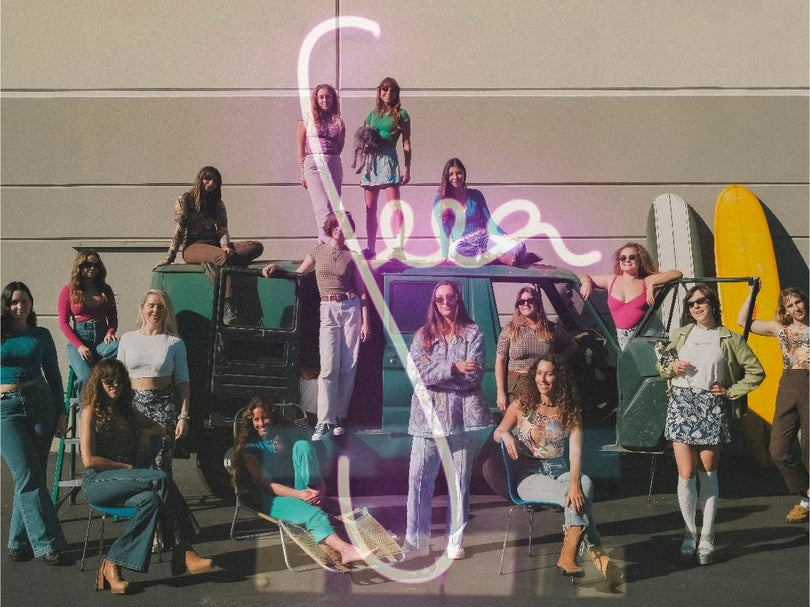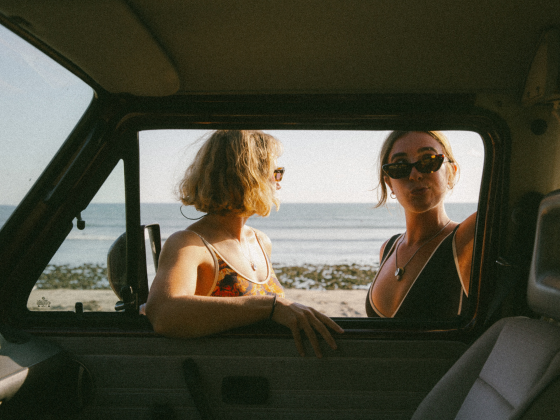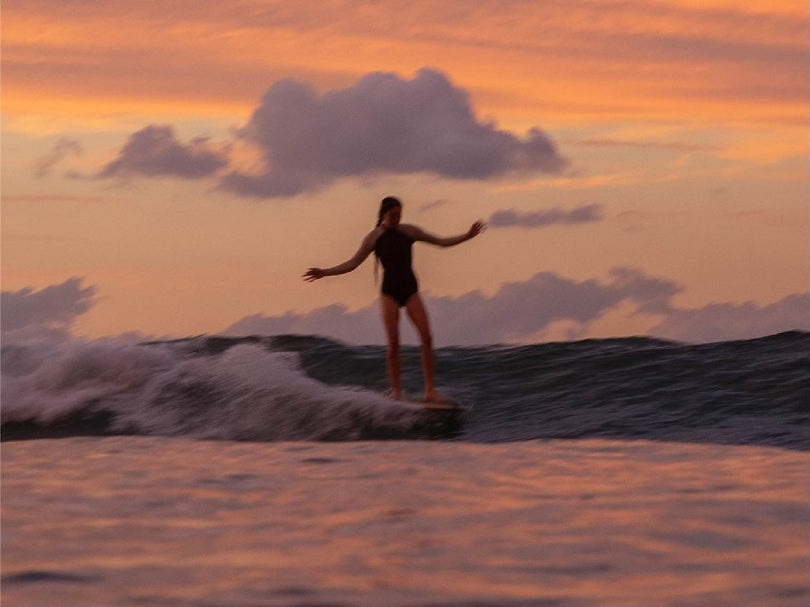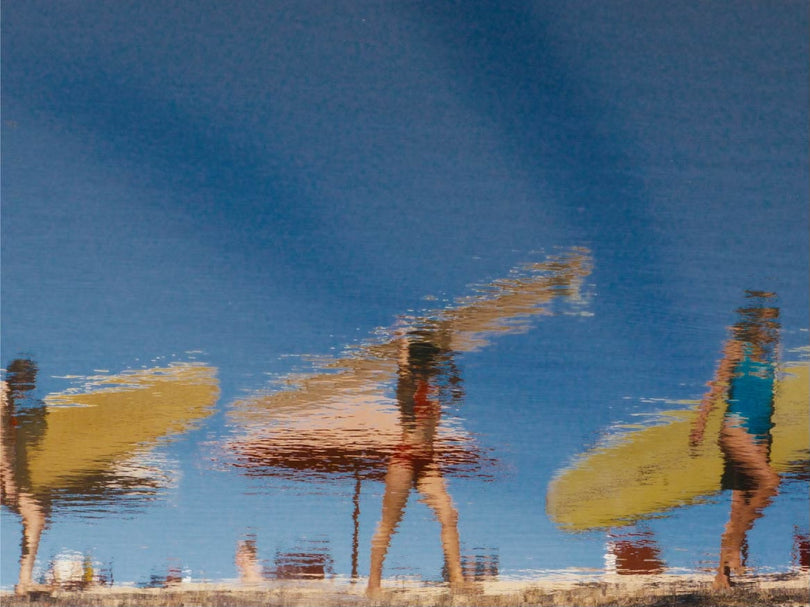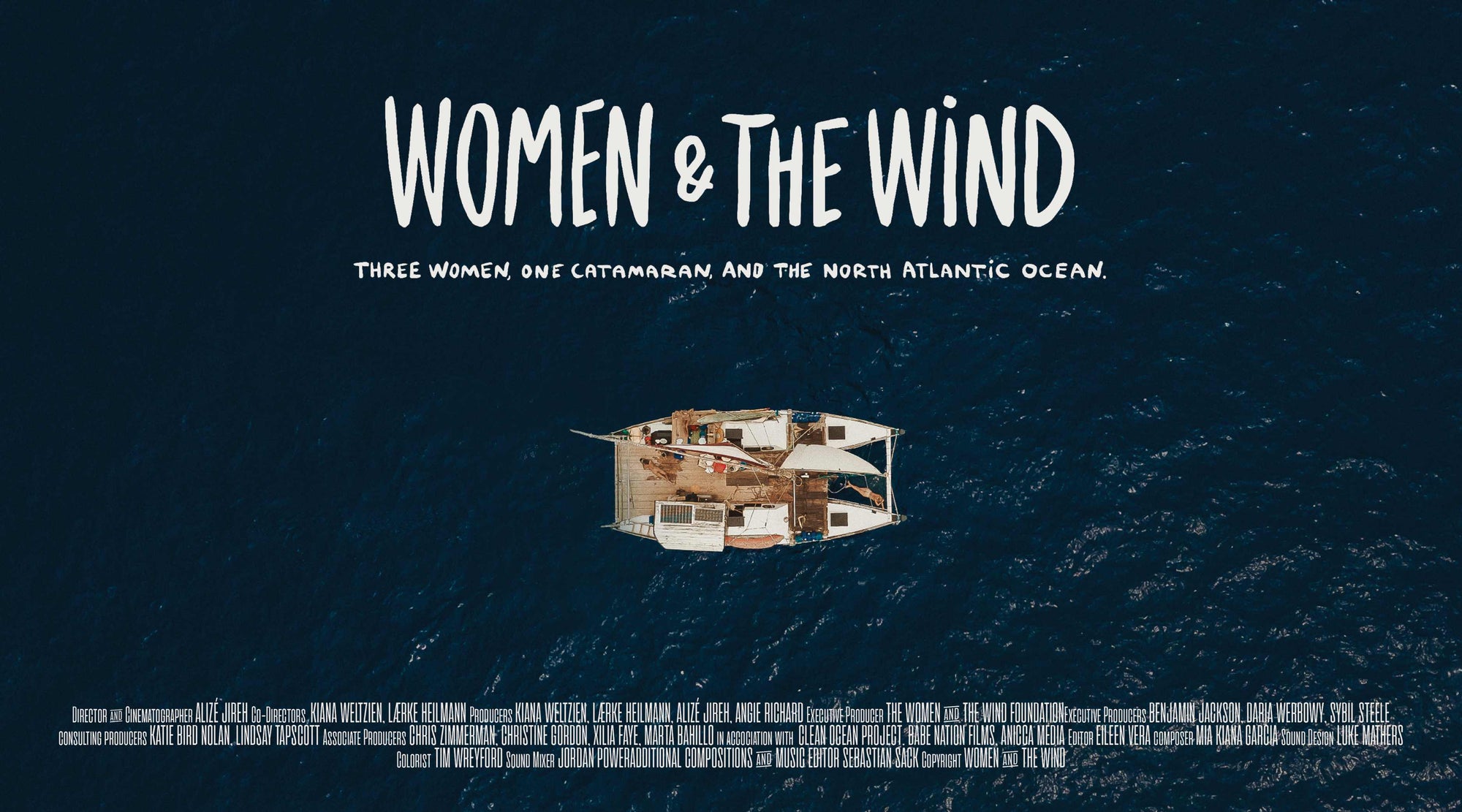Seea sat down with Laarni Gedo, owner and founder of flower farm Petal Mettle, artist (find her work here), and surfer for an intimate and vulnerable interview about life, loss, and regrowth. We hope you fall in love with Laarni's compassion, open heart, and adventurous spirit just like we did!
How did you find the courage to start painting and selling your work?
About a decade ago, I was five years into a 9-to-5 stable but soul-crushing office job. I was in my late 30s and felt really stifled by the absence of creativity in my job. After work, I needed to satisfy my need to create and found myself drawn to painting and my big love surfing. Ever since I was young, I’ve always loved drawing and painting, but I never thought that it would be something I could ever do for a living.
At that point in my life, I hadn’t done art in a long time, until one day, I stumbled upon a $20 bill on the ground. On a whim, I walked into an art shop and bought a 5-color acrylic paint set and a cheap, 3-pack of canvases. That paint set reignited a flame in my heart, and I found myself making art after work and on my days off, gifting what I made to friends. Soon, friends began to commission me, and it planted a seed in my mind.
Dive into Laarni's beautiful paintings HERE!

Laarni painting at the beach.
It really feels like you follow your gut! How did you start farming?
In 2015, I was presented with an opportunity to embark on a grand adventure that required me to make a difficult, lifestyle-changing decision. My partner at the time won a business plan competition, which awarded him 5 acres of land to farm for free for 5 years. The plan was to build a business that would grow vegetables for fermentation, such as radishes for kimchi, cabbages for sauerkraut, and beans for tempeh. After some mental grappling, I found the courage to quit my day job and move to the North Shore to become an artist and farmer.
One day, as I was walking through the onion beds, a bloom stopped me in my tracks; it was bursting at the seams with mini blooms. It reminded me of beautiful little ideas pushing their way to the surface. I was amazed that one tiny seed, with time and care, could become something so compelling and inspirational. If you look closely and pay attention, you can find beauty and life lessons in everything. That blooming onion, like the first wave I ever caught, changed my life and inspired me to grow plants.
At that time, the farm was one of the very few certified organic vegetable farms. With guidance from my farmer friends, I began planting flower seeds between the vegetable beds to attract beneficial insects and pollinators. I found myself spending more and more time on the farm, painting, farming, and surfing—living the dream I never knew I had.
Laarni's farm is called Petal Mettle! Check it out!

Laarni at her farm in O'ahu.
How did flowers and plants serve as a healing force for you and your family, and why did you want to share that power with others?
Medicinal or healing plants—what I like to call powerplants—such as Calendula, Yarrow, and Spilanthes entered my life during a challenging time when my father was nearing the end of his battle with cancer. I still remember receiving a phone call in early February 2017 from my parents in Maryland. My mom was crying uncontrollably in the background as my dad calmly explained that his ocular melanoma had metastasized to his liver. At that moment, I didn’t fully understand the implications; it was clear that he needed a miracle to survive.
My dad, mom, sister, and I are a tight-knit and private family, so we chose to care for my dad ourselves, with the hospice nurse checking in as needed. It was during this phase of caregiving that I discovered the power of plant medicine. I’ve always favored natural remedies over pharmaceuticals, but until then, my belief in the healing properties of plants was largely based on faith and friends’ testimonials.
My mom made coconut oil from scratch, a skill passed down from her mother in the Philippines, and she shared this knowledge with me. She would massage my dad’s swollen body with her coconut oil mixed with essential oils like frankincense, calendula, and lavender several times a day. I witnessed his skin improve, rashes disappear, and swelling reduce after each massage.
When you have just a few weeks left with a loved one, time seems to fly, yet there are moments when everything slows down, allowing you to love fiercely and be fully present. At that time, I wholeheartedly believed in the power of plants. If they could provide healing and comfort to a dying person’s body for even a few days, imagine their potential to address everyday challenges—a bug bite, a reef cut, a mild sunburn.
It was during these two months of saying goodbye to our dad and experiencing death and impending loss intimately that I knew with absolute clarity that I wanted to grow flowers and, most definitely, medicinal plants. Between caring for my dad, I began laying out my farm space, organizing my flower seed inventory, and selecting a farm name. I chose Petal to the Mettle because I loved the meaning of “mettle”, a person’s ability to cope well with difficulties or to face demanding situations in a spirited and resilient way. The name became too wordy (like me!) and eventually became Petal Mettle.
Why were you inspired to grow wildflowers and try cultivating different types of plants from the farms you saw around you? How do the flowers you grow influence your arrangements?
I’ve always been a supporter of local farms and farmers. Hawaiʻi imports about 85% of its food, and most flowers are flown in rather than grown locally. With Hawaiʻi's abundance of incredible flowers, I wanted to create a farm that offers my community an alternative to grocery store flowers that have likely traveled across continents.
While I love tropical flowers, my growing region isn't ideal for them. I've always had a fondness for wildflowers, so in addition to incorporating native Hawaiian plants for ground cover and windbreaks, I decided to cultivate flowers like zinnias, amaranth, celosias, marigolds, and sunflowers.
I adore wildflowers and enjoy arranging them to look natural and unstructured. Occasionally, I’ll follow a specific color palette for an arrangement, but 90% of the time, I create them based on what I see in my flower beds. As I taught myself the art of flower arranging, I picked up some useful basic techniques. However, beyond those fundamentals, there’s no particular reasoning or order in my arrangements; everything I create is driven by instinct. I’m truly grateful for friends and customers who appreciate the beauty in this colorful chaos.

Some of Laarni's beautiful flower arrangements. Find more on her Instagram @petalmettle.
How has farming given you a special perspective on life, living, and regrowth?
After my dad’s passing, the farm and the ocean became my places of grief. Kneeling in the dirt or weeding, I found myself at eye level with the plants and flowers, deepening my connection with nature. Farming in solitude provided moments of introspection, leading to waves of sadness and feelings of gratitude.
I watched the plants grow from seeds I started in trays to seedlings I planted in my flower beds. Farming taught me the importance of intention, attention, love, and gratitude. I learned to respect time and trust the process.
As my flowers budded and bloomed, they filled me with joy, hope, and love. I created bouquets from some of these flowers, either selling or gifting them. The smiles and appreciation I received in return fulfilled me deeply. I left some blooms on the plants to save seeds, observing as the vibrant flowers aged and transformed. Within weeks, they turned brown and lost their petals, producing hundreds of seeds before becoming skeletal remains, ready to be composted back into the earth. The thought that one flower can leave behind a legacy of many more, capable of spreading joy and love, filled me with hope and peace. Life is a privilege, and death is inevitable. What truly matters are the connections we make that give meaning to the time we have in between.
Do your paintings and your floral arrangements influence each other? How would you describe your artistry?
I’ve mostly painted waves and surf scenes initially because surfing was the sole love of my life. Once I started to build my farm, I was left with less and less time to paint. I felt torn. As if a part of me was fading out, and I was less and less of an artist. Then I realized that growing and arranging flowers IS art. Instead of paint and brush strokes on a canvas, I was creating shape, movement, and composition with flowers.
My bouquets are wild, like my flowers. I like to arrange and cut them as I walk through my flower beds. Often, the more imperfect, the more I like the flowers. They remind me of how I want to live my life—unapologetically me and unaffected by judgment.

How did you start surfing, and what does it mean to you?
I grew up in the Philippines, which was first occupied by Spaniards and later by Americans. This colonization left lasting impressions on our culture, one of which was a developed preference for lighter skin. My earliest memory is of running giddily along the beach, dodging gently lapping waves as they rolled to shore and turning around to catch them on their way back to the sea. I’ve always loved the ocean, but my family was so afraid of it that they never wanted to learn how to swim or be in it. Eventually, my mom recognized my passion for the water and enrolled me in swim lessons.
As a kid who spent most of my time outdoors, my skin often darkened several shades compared to the other kids. I developed a thicker skin from the negative comments about my complexion from peers and even some adult relatives. However, my love for the water never wavered, and I never felt less beautiful because being in the water simply felt right. This strong connection taught me early on to follow my heart and not be swayed by what others thought I should or shouldn’t be.
My love for the sea deepened when my family moved to Hawaiʻi, where I fell in love with surfing. My dad and I learned to surf together at a spot called White Plains. I was about 15 when my dad pushed me into a wave on a borrowed banana-yellow mini tanker. At first, I was scared, but that fear quickly transformed into a thrilling excitement that I knew I could never live without. That wave changed my life, helping me realize how much I loved being in Hawaiʻi. While I may travel to foreign places with beautiful waves, I know that Hawaiʻi will always be my home.
Surfing fills me with incredible joy, but it also brings a twinge of guilt because it can feel like a selfish activity. I’ve called in sick to work, canceled dates, and told countless little white lies just to catch good surf. But I truly believe that I am the best version of myself for my loved ones and my community when I am the happiest.

How is your relationship with the land related to your relationship with the ocean? Why should we care about our natural environment?
My connection to the ocean and the land is both physical and spiritual, and runs very deep. I turn to both places for inspiration. The ocean, regardless of how crowded or empty the lineup, has been a place for me to be alone with my thoughts and feelings. The land not only provided me with bounties of food and prolific flowers, my farm serves as a peaceful sanctuary for meditation.
I’m so grateful to have this intimate relationship with the ocean and the land. I think that paying attention, making connections, and finding awe-inspiring beauty in the most mundane of things like dew drops that look like diamonds on nasturtium leaves, and finding meaning—mind-blowingly life-changing, or fleeting like dew drops in the morning sun. These simple acts in nature, I think, bring us closer to understanding love and compassion. Ultimately, you get to a place where you can’t help but protect and nurture each other.
Love for Laarni!
Thank you to Laarni for opening her heart to Seea and sharing her brave and inspiring life with us! We can't thank you enough, Laarni!
Find Laarni:


